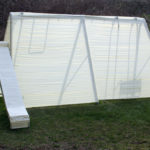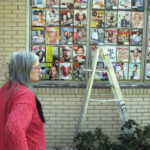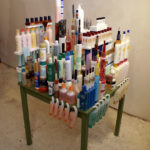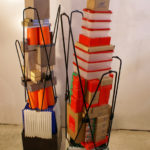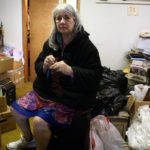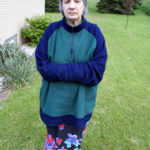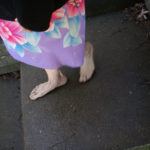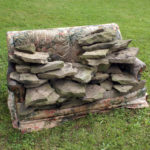Wade Schaming is an artist who works in many mediums: sculpture, photography, and installation. I met Wade at the Vermont Studio Center in February, 2014. Much of Wade’s art centers around his mother, a beautiful woman who lived with frontotemporal dementia that started when Wade was in his teens. Frontotemporal dementia is a neurological disease that is difficult to diagnose, but it changes behavior in ways that profoundly affect a family. Outbursts of anger, hoarding behavior, and eventually the inability to communicate are signposts of the disease’s progression. In visits home, Wade began photographing his mother’s decline.
MM: What were your first attempts at making art in/around your mother’s illness?
WS: After completing my undergraduate degree at the University of Pittsburgh in December 2006, I applied to several MFA programs in and around New York for the next fall. My plan was to use grad school as my ticket out of Pittsburgh and away from the chaos that was my life there. But, that spring I was denied admission to all the programs I applied. Defeated but determined to leave Pittsburgh, I started making outdoor installations in my parents’ backyard knowing that my portfolio of work needed to be stronger and not solely composed of my best projects from undergrad. It was then, the summer and fall of 2007, that these first attempts of making art around my mother happened. She was still undiagnosed and her driving privileges had not been revoked yet so my process was mostly uninterrupted and hidden from her. However, I remember one time using junk mail I took from the house and taping it to the base of a tulip poplar tree. She was home and came outside to see what I was doing. Her speech was already handicapped by then but she made it perfectly clear that she was angry with me for using something she hoarded. She started ripping the piece apart and then I became angry with her. I am sure I yelled at her but it wasn’t about her destroying my work, it was because of my continuing resentment against her. For years she kept our house a mess, and I had to lie for her to my friends as a kid and teenager as to why they couldn’t come over my house to play and visit like I did theirs.
MM: Did bringing your “art self” home reduce the stress of those visits?
WS: After reapplying, I was accepted to the School of Visual Arts’ MFA Fine Arts program in the fall of 2008. I made one installation at home in the summer of 2009 while on break but didn’t resume making work at home until after I was done with my studies in May 2010. I made work that summer and fall and beginning in April 2011, I started scheduling trips home to Pittsburgh every three months. Besides the responsibility I felt to visit my parents, my intention for those trips was to use materials I found in their home to make site-specific installations. Making art and the eventual photographing of my mother gave me purpose to be home but no, it did not reduce the stress. If I didn’t go there to make art I’m not so sure I would have gone as often if at all. I was always uncomfortable being there, it was like what I imagine going to prison as a visitor is like, you’re not the one that is in confinement but your freedom and sense of self is drastically limited. I had to hide my laptop and camera and cell phone from her at all times because if she would find my electronics, she would hide them. She may have lost the ability to do a lot of common things like brushing her teeth and taking a shower, but she never stopped hoarding.
MM: Was there a difference in the way you looked at your mother as an artist compared to how you looked at her as a son? I’m thinking about her various outfits.
WS: Her choice of everyday attire, a nightgown with a sweater or hooded jacket on top, was unusual and definitely added to the composition of the photographs. As an artist she was my muse. I’ve never liked photographing people and I still only like to photograph objects that I have set up. Photographing my mentally ill mother was different though. It felt important, like something I had to do. Every now and then I find myself looking at them and deciding which ones are good and which are bad. When I can say, “this one is good,” I’m an artist sorting out my work. When one is blurry or the composition is inadequate or I get caught up in the sadness and pain of seeing this person who gave me life yet is sick and dying, I’m a son with pictures of my mom.
MM: Did art help you connect with a woman who was no longer able to speak?
WS: I would like to say yes, but that would be a lie. Even though she became something else, she was still my mother, and yet, that mother-son connection was long gone. This contradiction was one of the hardest parts about her being alive and living with dementia. When she died I physically lost her, but I feel that I lost her some 10 years prior. No installation or sculpture or photograph could make up for that void I felt and still feel. I needed a mother in my late teens and early to mid-twenties. I had one, but I didn’t.
MM: When she saw your installations, what do you suppose she thought of them? Was she drawn to them? Puzzled? Intrigued?
WS: She was drawn to the works I made in 2010 and 2011 much differently than in 2007. I remember her pausing and looking. That stillness, which was not usual for her, made me think she might be was responding or understanding something visual. There were times she would try to preëmptively de-install the work for me but it was not as aggressive as in 2007 and when I would stop her she would move on and leave them alone. Her intrigue was what triggered my documentation of her.
MM: You began doing some documentary work around your mother’s illness. Was this to be a record of your mother’s illness or a record of your relationship to it—or both?
WS: It became a record of her illness but that was not my original intention. If you look at all the photographs I took of her in chronological order from 2010 to 2012 you can see her slowly falling apart. You can see the illness changing her. But when I think back to when I was doing it, I don’t think I knew what I was doing. There was even one trip, October 2011, where I didn’t take any photos of her. I’m not sure why I don’t have photographs from that trip, but it clearly shows that I didn’t have a plan. If I had a plan, I would have October 2011 photos. So I guess it was partly my relationship to the illness. I knew she was dying, even though I couldn’t accept that reality and denied it in a way. That childhood belief that your parents will live forever stayed with me until the moment I got that terrible phone call. Even then I was in denial.
MM: After your mom’s death, your art took a much different direction. Talk a little about the immediate aftermath of her death, specifically the couch installation.
WS: The last few months of her life she lost control of her bowels and urinated in her bed and on the couch in the living room. Before I came home from New York for the funeral, my dad threw away the bed but the couch was sitting in the garage for the following week’s garbage day. He let me delay its disposal and after the funeral I used it for an installation, adding sheet rock to where she sat. The weight of the rocks broke the couch and I left the piece in the yard for a couple of days. I guess you could say it was a metaphor for what had happened. The couch represented her life, worn and soiled. The placement of the rocks symbolized the impact of the illness, messy and irreversible. The breaking of the couch finalized the story.
After her death I started taking her things to my studio in New York, specifically Avon products and Tupperware that she hoarded from her days as a saleswoman. This “new” material formed the substance of my sculptures for the next year or so; up until you and I met at Vermont Studio Center in February 2014. However, the sculptures I made in Vermont came from materials I found throughout the town of Johnson, Vermont. This process returned me to my days at School of Visual Arts when I made work from things entirely found on the street. Before the Vermont Studio Center I thought my work needed to have my mother’s possessions in them to justify their creation. Now I can see that’s not so. That residency in Vermont definitely served its purpose by allowing me to free myself of my own rules.
MM: When did you see the possibilities of using objects your mom had collected? How much stuff was there down in the basement and out in the storage shed?
WS: There is still stuff in the basement and storage shed! My father has had a hard time moving on. It’s very frustrating for me to see him stuck, but I can’t imagine what it is like to lose the love of your life, especially the way he did. However, he has been very helpful with transporting her things from Pittsburgh to my studio in New York. I think the possibility of using these specific objects has always been on my mind but the timing was never right. Now that she’s gone, it’s now or never.
MM: Do you view your sculptures as ephemeral or permanent?
WS: I would suggest somewhere in between. My installations are definitely ephemeral–they don’t exist after I photograph them. My sculptures are tricky; the best they ever look are right after I am done building them in my studio. When I take them apart and reassemble them in a museum or gallery or exhibition space they are not quite the same, to my eye at least. Bonding the materials together with some kind of adhesive and making them more permanent would violate my process and just not feel right. They exist because of their internal struggle with balance. They are sculptures made up of objects with past lives that no longer function. To not allow them to defy gravity on their own would take away from what they are–assembled objects with a new purpose.
MM: Did you ever try to make art with your mom or dad during this long care-giving period?
WS: When I was home for Christmas in 2008 I tried drawing with her as I did when I was a child. We had always drawn Christmas trees together when I was young and at any time of the year. I remember her leading the way as my childish marks followed. In 2008, it was reversed. She would only mimic what I drew on the paper. So, I would draw one side of a tree and she would complete the other, before hiding the pen somewhere. That’s the last time I can remember drawing with her.
MM: Do you think making art could help people who are caregivers? Do you have to know how to draw to make art?
WS: Of course art making would help caregivers, the problem is there is no down time to do so. Caregivers are giving care 24/7, what they need is someone to care for them. If my dad had more help when my mom was sick, I think it would have relieved a lot of his stress. Ideally, I think if people who have first-hand experience caring for people with dementia could organize and help others in the same situation, current caregivers wouldn’t feel so isolated and alone. Anyone can make art, most people just choose not to. Drawing a portrait or landscape or some kind of representative thing from this world isn’t the only way to make art. I think people who go through these kinds of traumatic experiences have the most to offer us in some form of expression, especially through the visual language.
MM: Have you reached a point where you think, “I’m pretty much done with that,” or can you imagine a day when you might want to revisit the issue of your mother’s illness, its long duration, and the impact it had on your family?
WS: I don’t think I can ever escape her or the impact of her illness, even if I wanted to.
For more, see Wade Schaming’s website.
http://wadeschaming.com/home.html
http://wadeschaming.com/home.html

